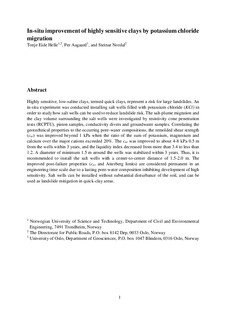| dc.contributor.author | Helle, Tonje Eide | |
| dc.contributor.author | Aagaard, Per | |
| dc.contributor.author | Nordal, Steinar | |
| dc.date.accessioned | 2017-11-09T14:47:47Z | |
| dc.date.available | 2017-11-09T14:47:47Z | |
| dc.date.created | 2017-07-27T20:27:35Z | |
| dc.date.issued | 2017 | |
| dc.identifier.citation | Journal of Geotechnical and Geoenvironmental Engineering. 2017, 143 (10), . | nb_NO |
| dc.identifier.issn | 1090-0241 | |
| dc.identifier.uri | http://hdl.handle.net/11250/2465367 | |
| dc.description.abstract | Highly sensitive, low-saline clays, termed quick clays, represent a risk for large landslides. An in situ experiment was conducted in which salt wells filled with potassium chloride were installed to study how salt wells can be used to reduce landslide risk. Salt-plume migration and clay volume surrounding the salt wells were investigated by resistivity cone penetration testing (RCPTu), piston samples, conductivity divers, and groundwater samples. Correlating geotechnical properties with pore-water compositions, the remolded shear strength (curcur) was improved beyond 1 kPa when the ratio of the sum of potassium, magnesium, and calcium to the major cations exceeded 20%. The value of curcur increased to approximately 4–8 kPa at a distance of 0.5 m from the wells within 3 years, and the liquidity index (LI) decreased from more than 3.4 to less than 1.2. A minimum diameter of 1.5 m around the wells was stabilized within three years. It is recommended that salt wells be installed at a center-to-center distance of 1.5–2.0 m. The improved postfailure properties (curcur and Atterberg limits) are considered permanent in an engineering timescale because of a lasting pore-water composition that inhibits development of high sensitivity. Salt wells can be installed without substantial disturbance of the soil and can be used as landslide mitigation in quick-clay areas. | nb_NO |
| dc.language.iso | eng | nb_NO |
| dc.publisher | American Society of Civil Engineers | nb_NO |
| dc.title | In Situ Improvement of Highly Sensitive Clays by Potassium Chloride Migration | nb_NO |
| dc.type | Journal article | nb_NO |
| dc.type | Peer reviewed | nb_NO |
| dc.description.version | acceptedVersion | nb_NO |
| dc.source.pagenumber | 13 | nb_NO |
| dc.source.volume | 143 | nb_NO |
| dc.source.journal | Journal of Geotechnical and Geoenvironmental Engineering | nb_NO |
| dc.source.issue | 10 | nb_NO |
| dc.identifier.doi | https://doi.org/10.1061/(ASCE)GT.1943-5606.0001774 | |
| dc.identifier.cristin | 1483263 | |
| dc.description.localcode | © American Society of Civil Engineers 2017. This is the authors accepted and refereed manuscript to the article. | nb_NO |
| cristin.unitcode | 194,64,35,0 | |
| cristin.unitname | Institutt for bygg, anlegg og transport | |
| cristin.ispublished | true | |
| cristin.fulltext | postprint | |
| cristin.qualitycode | 2 | |
